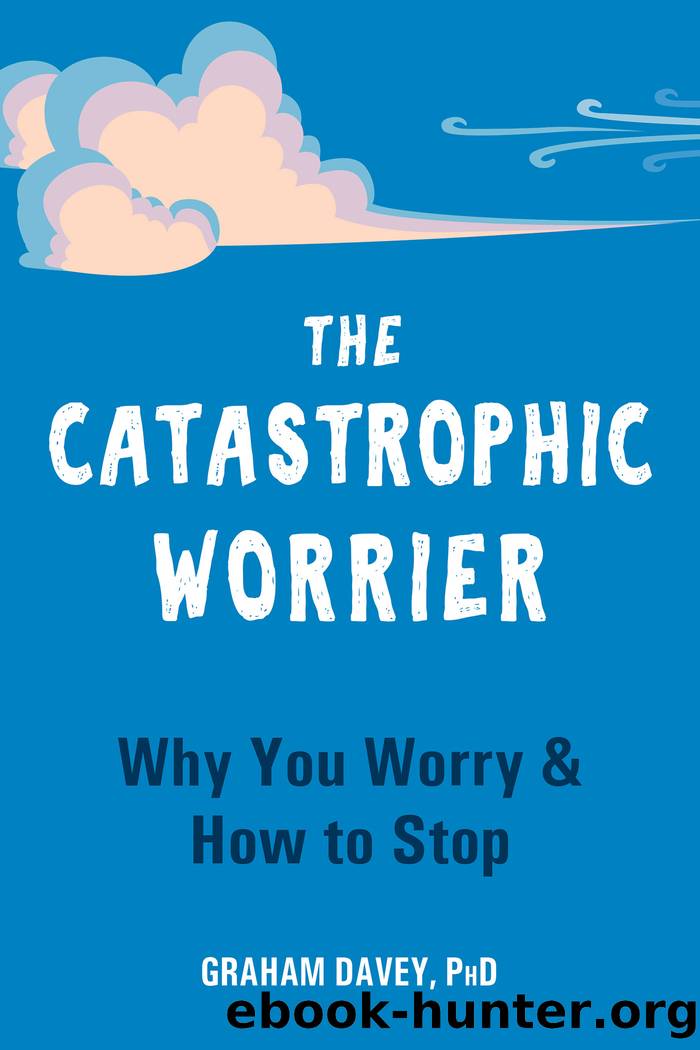The Catastrophic Worrier: Why You Worry and How to Stop by Graham Davey

Author:Graham Davey
Language: eng
Format: epub
Publisher: New Harbinger Publications
Published: 2023-03-02T15:00:03+00:00
Worry and AnxietyâVive la Différence!
Worry Fact 3. Anxiety-free worry is associated with âpositiveâ characteristics, such as problem-focused coping strategies and an information-seeking cognitive style.
Worry Fact 4. Anxiety per se is associated with characteristics that often lead to poor psychological outcomes, such as poor problem-solving confidence, poor perceived control over problems, taking responsibility for negative but not for positive outcomes, a tendency to define events as threats, and avoidance and emotion-focused coping strategies.
Together with colleagues James Hampton, Jola Farrell, and Sue Davidson at the City University in London, one of the first worry studies I conducted was designed to establish the possible differences between anxiety and worry.93 We already knew that anxiety was an emotion, whereas worry was a cognitive activity. But we wanted to know if there were any defining features that clearly made worrying distinct from anxiety. Given what little evidence was available at the time, we decided to throw the kitchen sink at this.
We conducted a survey asking participants questions about a broad range of thingsânot just their worrying and levels of anxiety, but also the types of coping strategies they used, their experience of mental health problems, and their use of cognitive strategies we knew to be risk factors for anxiety-based mental health problems. Once our filing cabinets were heaving with data, we used statistical techniques to discover what worry looked like when we stripped it of anything associated with anxiety. And we did the same to anxiety: What did anxiety look like when we stripped it of anything related to worry?
When you look at worry and anxiety in this way, they turn out to be quite different things. Anxiety-free worry was characterized by the use of adaptive, problem-focused coping strategies and an information-seeking cognitive style andâperhaps surprisinglyâalso with avoidance coping and emotion-focused coping (attempts to regulate stress during exposure to negative events).
However, when anxiety was stripped of any factors related to worry, it was a completely different kettle of fish. Worry-free anxiety was characterized by several psychological processes that are normally considered to result in poor psychological outcomes. These included poor problem-solving confidence, poor perceived personal control over problems, beating yourself up by taking responsibility for negative but not for positive outcomes, a tendency to define events as threats, and avoidance and emotion-focused coping strategies. This is anxiety trying to keep you safe but making you paranoid and distressed in the processâa strategy that probably works, but at a psychological cost.
Itâs hard to avoid seeing these results in a black-and-white way. Worrying was associated largely with very positive traits, such as use of adaptive problem-focused coping (dealing with a problem by trying to find a solution to it) and an information-seeking cognitive style (seeking information to inform you about a problem). In contrast, measures of anxiety were associated largely with processes considered to result in poor psychological outcomes, which ultimately could give rise to anxiety-based mental health problems. What jumps out when you consider these findings is that worry appears to be âgoodâ and anxiety is
Download
This site does not store any files on its server. We only index and link to content provided by other sites. Please contact the content providers to delete copyright contents if any and email us, we'll remove relevant links or contents immediately.
| Adult Children of Alcoholics | Alcoholism |
| Drug Dependency | Gambling |
| Hoarding | Obsessive Compulsive Disorder (OCD) |
| Sexual | Smoking |
| Substance Abuse | Twelve-Step Programs |
The Hacking of the American Mind by Robert H. Lustig(3591)
Right Here, Right Now by Georgia Beers(3515)
Fingerprints of the Gods by Graham Hancock(3231)
Goodbye Paradise(2987)
Bad Pharma by Ben Goldacre(2738)
Happiness by Matthieu Ricard(2535)
More Language of Letting Go: 366 New Daily Meditations by Melody Beattie(2461)
The Social Psychology of Inequality by Unknown(2323)
Drugs Unlimited by Mike Power(2198)
The Plant Paradox by Dr. Steven R. Gundry M.D(2055)
Confessions of a Shopaholic by Sophie Kinsella(1880)
Borders by unknow(1793)
Make Love Not Porn by Cindy Gallop(1755)
Dry by Augusten Burroughs(1692)
Stop Being Mean to Yourself: A Story About Finding the True Meaning of Self-Love by Melody Beattie(1660)
Getting Off by Erica Garza(1626)
Yoga and the Twelve-Step Path by Kyczy Hawk(1539)
Weed, Inc. by Ben Cort(1518)
Unmasking Male Depression by Archibald D. Hart(1511)
